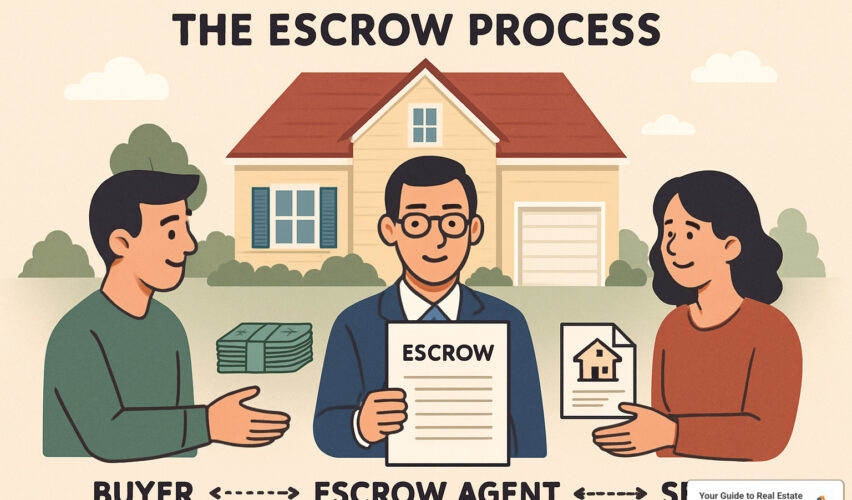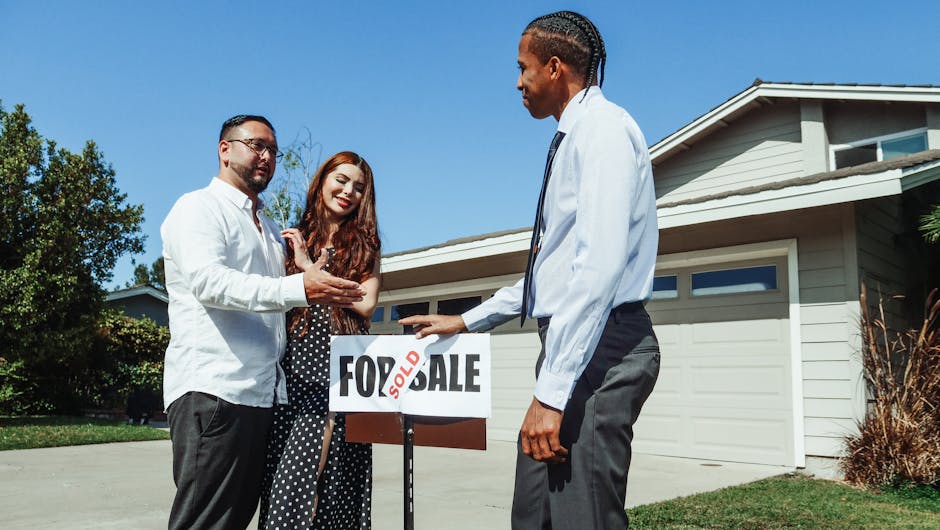Explaining the Escrow Process
Understanding escrow process is essential for anyone buying or selling a home. At its core, escrow is a financial arrangement where a neutral third party holds and regulates payment of funds and documents during a real estate transaction.
Here’s a quick overview of the escrow process:
- Opening escrow: After a purchase agreement is signed, an escrow account is opened
- Deposit funds: Buyer deposits earnest money (typically 1-3% of purchase price)
- Meet conditions: All parties complete inspections, appraisals, financing requirements
- Close escrow: Documents are signed, funds transferred, and property ownership changes hands
Escrow serves as a protective buffer between buyers and sellers, ensuring neither party completes their end of the deal until all conditions are met. Think of it as a secure holding area for your most important transaction documents and money.
“An escrow is a process wherein the Buyer and Seller deposit written instructions, documents, and funds with a neutral third party until certain conditions are fulfilled,” according to industry experts. This neutral arrangement protects everyone involved.
The escrow process typically takes 30-60 days to complete, though this varies based on transaction complexity, financing requirements, and local practices. In California and many western states, escrow is the standard closing process, while some eastern regions use “table closings” instead.
For first-time homebuyers, escrow can seem like a mysterious black box. But understanding this crucial step helps you steer one of the biggest financial transactions of your life with confidence and clarity.

Understanding escrow process basics:
– how to shop mortgage
– mortgage payment calculator online
Why this guide matters
If you’re a first-time homebuyer, the word “escrow” might sound like an exotic financial term designed to confuse you. You’re not alone! At YourGuideToRealEstate.net, we’ve found that escrow consistently ranks among the most misunderstood aspects of real estate transactions.
This guide aims to bust through the confusion and explain the entire process. By understanding escrow, you’ll reduce your risk, protect your investment, and approach your home purchase with confidence rather than anxiety.
As one of our recent clients told us: “I was terrified of making a mistake during escrow until I actually understood what was happening. Knowledge really is power when it comes to buying a home.”
Escrow Basics: What, Why, and When
Think of escrow as your financial safety net when buying a home. It’s simply an arrangement where a neutral third party (the escrow agent) holds onto important documents and money until everyone fulfills their promises in the real estate transaction. This trusted middleman ensures nobody hands over their home or hard-earned cash until all conditions have been satisfied.
Understanding escrow process starts with recognizing why it exists in the first place – to protect you! Whether you’re buying or selling, escrow creates a buffer that ensures everyone plays by the rules.

If you’re in California or most western states, escrow is just how things are done. It’s the standard closing procedure for buying, selling, or refinancing property. California takes escrow seriously – all providers must be licensed through either the Department of Business Oversight (for independent companies) or the Department of Real Estate (for broker-controlled escrows).
Meanwhile, in many eastern states, you might experience “table closings” instead, where everyone gathers around a table to sign papers and complete the transaction all at once.
One term you’ll hear often is the “cushion requirement.” Most lenders require you to keep at least 2 months’ worth of extra payments in your escrow account. This isn’t just them being cautious – it ensures there’s enough money to cover unexpected increases in taxes or insurance costs.
Government-backed loans have even stricter requirements:
– FHA loans always require escrow accounts – no exceptions
– VA loans require escrow unless you’re putting down at least 10% and have stellar credit
– USDA loans also make escrow mandatory
For a deeper dive into closing procedures, check out Home Closing 101 for additional guidance.
Escrow vs. Earnest Money
“Wait, isn’t earnest money the same as escrow?” I hear this question all the time from first-time buyers. Let me clear things up:
Earnest money is your “I’m serious about this house” deposit. It typically amounts to 1-3% of the home’s purchase price and shows sellers you’re committed. This good-faith deposit demonstrates you’re not just window shopping.
Escrow is where that earnest money is safely held. Think of escrow as the secure vault and earnest money as one of the valuables stored inside.
As one California escrow officer colorfully explained to me: “Earnest money is your skin in the game, and escrow is the secure vault where that money is protected until everyone keeps their promises.”
If your home purchase goes smoothly, your earnest money typically gets applied toward your down payment or closing costs. If the deal falls apart because of a failed inspection or another contingency in your contract, you’ll usually get that money back. However, if you simply change your mind for reasons not covered by contingencies, the seller might keep your earnest money as compensation for taking their home off the market.
Escrow Accounts After Closing
Congratulations on your new home! But wait – escrow isn’t done with you yet. After closing, you’ll likely have another type of escrow account that sticks around for the life of your mortgage. Some folks call this an “impound account,” and it serves a different purpose than the escrow used during the home buying process.
This post-closing escrow account is like a forced savings plan for your big housing expenses. Each month, a portion of your mortgage payment gets set aside to cover:
- Property taxes (which can be a shocking bill if you have to pay it all at once)
- Homeowners insurance premiums
- Mortgage insurance (if applicable)
Instead of scrambling to find thousands of dollars when these bills come due, your lender collects 1/12 of the estimated annual amount each month. When it’s time to pay, your servicer handles it automatically from this account.
Two-month cushion we mentioned? This is where it comes into play. Every year, your loan servicer conducts an “escrow analysis” to make sure they’re collecting the right amount. If they’ve collected too much (over $50 typically), you’ll get a refund. If there’s a shortage, you can either pay it all at once or spread the difference over your next year’s payments.
These shortages happen most often right after you buy a home, especially if property taxes get reassessed and jump up significantly in your first year of ownership. It’s not uncommon to get that letter saying your mortgage payment is increasing due to an escrow shortage – just part of the joys of homeownership!
For a more comprehensive look at mortgage payments and how escrow accounts work long-term, take a peek at our guide on Understanding Mortgages.
Understanding Escrow Process: Step-by-Step Timeline
Let’s walk through what actually happens during escrow. Think of it as a road trip with important stops along the way—each one bringing you closer to the keys to your new home.
Most escrow periods last between 30 to 60 days, though yours might be shorter or longer depending on your specific situation. Here’s the journey your transaction will take:

Opening Escrow – First 48 Hours of the understanding escrow process
The moment your offer is accepted, the clock starts ticking. Those first 48 hours are a flurry of activity that sets the stage for everything that follows.
First, you’ll need to choose an escrow holder—the neutral third party who’ll manage the transaction. Depending on where you live, this choice might fall to you as the buyer, to the seller, or it might be a mutual decision outlined in your purchase agreement.
Within 1-3 business days, you’ll need to deposit your earnest money. This is your financial commitment that says, “I’m serious about buying this home.” Your real estate agent will guide you on whether to send a check or wire transfer—just be extremely careful with wire instructions to avoid fraud.
Behind the scenes, the escrow officer is busy drafting escrow instructions based on your purchase agreement. These instructions are the rulebook for your transaction, spelling out exactly what needs to happen before money changes hands and you get your deed.

“The first 48 hours of escrow are critical,” a veteran California escrow officer told me recently. “This is when we establish the roadmap for the entire transaction. Clear instructions at this stage prevent confusion later.”
During this kickoff phase, take time to read everything carefully before signing. Don’t hesitate to ask questions—there’s no such thing as a silly question when it comes to the biggest purchase of your life. Double-check that the escrow instructions match what you agreed to in your purchase agreement, and always verify that your earnest money deposit was properly received and documented.
Mid-Escrow Milestones & Contingencies in the understanding escrow process
The middle stretch of escrow is where the real work happens. This is when you’ll be checking off contingencies—those conditions that must be satisfied before you’re obligated to complete the purchase.
Home inspection typically happens within 7-10 days of entering escrow. This is your opportunity to learn about any issues with the property. Your inspector will check everything from the foundation to the roof, giving you a detailed report of what might need attention. Based on what they find, you might accept the home as-is, ask for repairs or credits, try to negotiate a lower price, or even walk away if there are serious problems.
The appraisal contingency usually comes next, about 2-3 weeks into escrow. Your lender will send a professional appraiser to determine the home’s value. If the appraisal comes in lower than your offer price, you’ll need to decide whether to make up the difference in cash, negotiate with the seller, or potentially exit the deal.
While all this is happening, your lender is working on final loan approval. Even though you were pre-approved, they’ll now verify everything: employment, assets, debts, and credit. This process typically takes 2-4 weeks, and they may request additional documentation along the way. Pro tip: respond quickly to these requests to keep things moving smoothly.
You’ll also be reviewing the seller’s disclosures about the property’s condition and history. Take these seriously—they can reveal important information about past repairs, neighborhood issues, or other factors that might affect your decision.
During this phase, communication is absolutely crucial. Stay in regular contact with your lender, agent, and escrow officer. And as the Consumer Financial Protection Bureau advises, avoid making major financial changes during this time. Now is not the moment to buy a new car, change jobs, or open new credit cards—any of these could derail your mortgage approval.
Closing Escrow: Final Steps in the understanding escrow process
As you approach the finish line, several important steps remain before you can call that house your home.
Your final walk-through usually happens 24-48 hours before closing. This is your last chance to verify the property’s condition before it becomes yours. Make sure all agreed-upon repairs have been completed, no new damage has occurred, and all included fixtures and appliances are still there. If the seller has already moved out, confirm they haven’t left unwanted items behind (unless that was part of your agreement).
At least three business days before closing, your lender will provide a Closing Disclosure detailing all costs. Compare this carefully to your initial Loan Estimate—any significant differences should be explained to your satisfaction.
Next comes the document signing. Unlike what you might see in movies, buyers and sellers rarely sign papers together at the same table. Your signing appointment will be more extensive since it includes all your loan documents. Take your time and make sure you understand what you’re signing.
After signing, the lender reviews all documents and releases funds to the escrow company (funding). This typically happens 1-2 days after signing. The escrow company then records the new deed with the county, officially transferring ownership to you. This usually occurs the day after funding.
Once recording is confirmed, the escrow officer disburses funds to all parties, and you finally get the keys to your new home!
| Escrow Closing | Table Closing |
|---|---|
| Parties sign documents separately | All parties meet together to sign |
| Process takes several days from signing to funding | Transaction typically completed in one day |
| Common in Western states (CA, OR, WA) | Common in Eastern and Midwestern states |
| Escrow company or title company handles process | Attorney often oversees closing |
| Documents recorded before funds disbursed | Funds disbursed at signing table |
“The final days of escrow can feel like a roller coaster,” a California real estate agent shared with me. “But if you’ve done your due diligence throughout the process, closing should go smoothly.”
While this timeline represents a typical escrow process, your experience may vary depending on your location, the complexity of your transaction, and local practices. The key is staying informed, responsive, and patient as you steer the path to homeownership.
Key Players, Accounts, Costs & Contingencies
Understanding escrow process involves getting to know the team of professionals who’ll guide your transaction from offer to closing. Think of them as your real estate dream team – each with their own special role to play.

Your escrow journey will be led by an escrow officer – the neutral referee who manages your account, processes documents, and makes sure everyone plays by the rules. Depending on where you live, this trusted guide might work for an independent escrow company (in California, these are licensed by the Department of Business Oversight), a title company (the most common arrangement), your real estate brokerage, or sometimes a bank or attorney.
Working alongside them is the title company, which acts like a property detective, investigating the home’s ownership history and uncovering any potential claims or liens that might cause problems down the road. They’ll also provide title insurance – your protection against future ownership disputes.
Your lender is another key player, providing the financing for your purchase and setting the requirements for loan approval. They’ll order the appraisal and work closely with the escrow officer to ensure all financial details are in order.
Of course, your real estate agents remain your champions throughout, representing your interests, communicating with other parties, and helping steer contingencies and negotiations. As one agent told me, “We’re like the translators who help buyers and sellers understand what’s happening behind the scenes.”
In some states, especially in the Northeast, attorneys handle closings instead of escrow companies. Even in escrow states like California, you might bring in an attorney for complex transactions or unique situations.
When it comes to costs, escrow isn’t free – but it’s money well spent for the protection it provides. Expect to pay about 1-2% of your home’s purchase price in escrow-related fees, though this varies by location and how complex your transaction is. These costs typically include the escrow company fee, title search and insurance, recording fees, notary services, wire transfers, and document preparation.
You’ll also encounter prorations during escrow – the fair division of ongoing expenses like property taxes, HOA dues, and utility bills between buyer and seller based on the closing date. If you’re closing on the 15th of the month, for example, the seller typically pays for the first half of the month’s expenses, and you’ll cover the rest.
All these costs are clearly itemized in your Closing Disclosure (which replaced the HUD-1 Settlement Statement for most transactions), so you’ll see exactly where your money is going.
Contingencies are your safety nets during escrow. The most common ones include:
Inspection contingency: Your chance to find any issues with the property and either back out or renegotiate if significant problems emerge.
Financing contingency: Protects you if your loan falls through for reasons beyond your control.
Appraisal contingency: Lets you cancel or renegotiate if the home appraises below your offer price.
Title contingency: Your escape hatch if serious title issues can’t be resolved.
Home sale contingency: Makes your purchase dependent on selling your current home first.
Sometimes, certain aspects of a transaction can’t be completed before closing. That’s when an escrow holdback comes into play. For example, if the seller needs to stay in the home for a week after closing, or if agreed-upon repairs can’t be finished in time, funds can be held in escrow until these conditions are met.
“Escrow holdbacks are like insurance policies for unfinished business,” explains a veteran escrow officer. “They allow the deal to close while protecting both parties.”
Wire fraud has unfortunately become a serious concern in real estate transactions. The FBI reports millions in losses each year from criminals who intercept emails and provide fake wire instructions. Always verify wire instructions by phone before sending funds, using a number you’ve independently confirmed. Be extremely wary of last-minute changes to wiring instructions – this is often a red flag for fraud.
For a more comprehensive look at the entire home buying journey, check out our guide on Easy Steps to Buying Your First Home.
Who Chooses the Escrow Company?
The question of who picks the escrow company often creates confusion – and sometimes tension – in real estate deals. In California, local customs typically dictate this choice:
In Southern California, sellers usually select the escrow company, while in Northern California, the buyer’s agent often makes this choice. If you’re buying in a hot market, you might agree to use the seller’s preferred escrow company simply to make your offer more attractive.
“Choosing an escrow company is about trust and efficiency,” explains a real estate broker with 20 years of experience. “Most agents have relationships with escrow officers they trust to handle transactions smoothly.”
Your purchase contract should clearly specify which escrow company will handle your transaction. If this matters to you, negotiate this point before signing the contract. When discussing who’ll select the escrow company, consider local customs (swimming against the current rarely helps), the reputation of the proposed company, their fee structure, and convenient locations for document signing.
Regardless of who chooses the escrow company, the escrow officer is legally obligated to remain neutral and follow the written instructions from both buyer and seller.
Documents & Funds Held in Escrow
During escrow, your escrow officer becomes the guardian of crucial documents and substantial funds. They’ll safekeep your signed purchase agreement – the foundation of your entire transaction – along with detailed escrow instructions that spell out exactly what conditions must be met before closing.
They’ll also hold title documents, including the preliminary title report and eventually the deed that transfers ownership, plus all your loan documents – the paperwork related to your mortgage, including the promissory note and deed of trust.
Important disclosures about the property’s condition and history, inspection reports, proof of homeowner’s insurance, and payoff demands from the seller’s existing lenders all find their temporary home in escrow.
On the financial side, your earnest money deposit (typically 1-3% of the purchase price) sits safely in escrow, joined later by the remainder of your down payment just before closing. Your lender’s loan funds, various closing costs, and prorated amounts for ongoing expenses all flow through this secure channel.
“The escrow holder acts as a secure vault for all these critical items,” says a California escrow officer. “Nothing is released until all conditions are satisfied and both parties have given their approval.”
Avoiding Pitfalls & Shortages
Even after the champagne toast in your new home, escrow accounts can present challenges. Many new homeowners are surprised when their mortgage payment increases during the first year due to escrow shortages.
Property tax reassessment is often the culprit. In many states, property taxes are reassessed after a sale, frequently resulting in higher tax bills than the seller was paying. In California, you might receive supplemental tax bills that reflect the difference between the previous owner’s tax assessment and your new assessment. These bills sometimes come directly to you rather than being paid through your escrow account.
Insurance premium increases can also create escrow shortages. When these shortages occur, you’ll typically have two options: pay the shortage amount in one lump sum, or spread it across the next 12 months by temporarily increasing your monthly mortgage payment.
Your lender will conduct an annual escrow analysis to check if they’re collecting enough for taxes and insurance. This annual check-up helps prevent major surprises, but it’s still wise to budget for potential increases, especially in your first year of ownership.
Wire fraud prevention deserves special attention in today’s digital world. Never send financial information via email, always verify wire instructions by calling your escrow officer using a phone number you’ve independently verified (not one provided in an email), and be extremely suspicious of last-minute changes to wire instructions. After sending funds, confirm receipt with your escrow officer promptly.
For more detailed information on escrow accounts and consumer protections, the Consumer Financial Protection Bureau offers comprehensive guidance worth reviewing.
At YourGuideToRealEstate.net, we’ve found that understanding these key players and processes helps our clients approach escrow with confidence rather than confusion. Knowledge truly is your best protection during this critical phase of your real estate journey.
Frequently Asked Questions about the Escrow Process
How long does escrow typically take?
Most homebuyers can expect the escrow process to take between 30-60 days from start to finish. That said, every real estate transaction has its own rhythm and timeline, influenced by several key factors.
If you’re using a conventional loan, you’ll typically close faster than someone with an FHA or VA loan, which require additional steps and inspections. Cash buyers have the fastest path through escrow, sometimes wrapping everything up in just 7-10 days without financing contingencies slowing things down.
The complexity of your transaction plays a significant role too. A straightforward single-family home purchase typically moves quicker than buying a multi-unit building or commercial property with more moving parts and requirements.
I spoke with a real estate attorney recently who emphasized: “The key to a smooth escrow is setting realistic timeframes from the beginning. Rushing through escrow increases the risk of mistakes that could cost you later.”
Local customs matter as well—some regions of the country naturally have shorter or longer typical escrow periods. If you need a faster or slower closing timeline than what’s standard, make sure to negotiate this in your purchase agreement before escrow begins. Once escrow is open, changing the closing date usually requires a formal amendment that both parties must sign.
What happens if escrow is cancelled?
Sometimes life happens, and real estate deals fall apart. Escrow cancellations occur for various reasons—financing falls through, inspections reveal deal-breaking problems, appraisals come in too low, or someone’s circumstances change unexpectedly.
When escrow gets cancelled, the most immediate concern for most buyers is: “What happens to my earnest money?” The answer depends on several factors, including why the deal is being cancelled, whether you properly exercised your contingencies, and the specific language in your purchase agreement.
Both parties typically sign a mutual release form that terminates the purchase agreement and instructs the escrow holder on how to handle any funds. Even though the transaction won’t close, you might still be responsible for certain costs already incurred—things like escrow cancellation fees, title search fees, appraisal costs, and inspection expenses.
If there’s a dispute over the earnest money deposit, things get more complicated. The escrow company can’t simply release the funds without either written agreement from both parties or a court order. In contentious situations, that money might remain in escrow limbo until you reach an agreement, possibly through mediation or arbitration as specified in your contract.
This is exactly why having proper contingencies in place is so important—they protect your earnest money when legitimate issues arise.
Can I choose to waive my post-closing escrow account?
Many new homeowners wonder if they can manage their own tax and insurance payments rather than having them bundled into their monthly mortgage payment. The short answer is: it depends.
Different loan types have different requirements. FHA and USDA loans always require escrow accounts, while VA loans typically require them unless you’ve made a down payment of at least 10%. With conventional loans, you may be able to waive escrow if you have at least 20% equity in the home.
Beyond loan type requirements, individual lenders have their own policies. Some charge a fee (typically 0.25% of your loan amount) to waive escrow. Others consider your credit score and payment history when deciding whether to approve an escrow waiver.
Understanding escrow process choices means weighing the pros and cons:
On the plus side, waiving escrow gives you control over your money until tax and insurance bills are due. You might earn interest on these funds in your own accounts, and you avoid the potential for escrow shortages and payment adjustments.
The downside? You become responsible for budgeting for large, lump-sum payments that might otherwise sneak up on you. Missing tax payments could result in penalties or even a tax lien, while lapsed insurance coverage puts both you and the lender at serious risk.
A mortgage advisor I consulted put it this way: “Managing your own tax and insurance payments requires discipline. Many homeowners prefer the convenience of escrow accounts despite the potential benefits of handling these payments themselves.”
If you’re interested in waiving escrow, bring this up with your lender before closing. Changing the arrangement afterward becomes much more difficult and may require a formal review of your loan terms.
For more detailed information about navigating your first home purchase, check out our First-Time Homebuyers Toolkit for comprehensive guidance through every step of the process.
Conclusion
Understanding escrow process is like finally seeing the complete roadmap for your home buying or selling journey. After navigating the twists and turns of this financial arrangement, you can appreciate how this neutral third-party system protects everyone involved in what’s likely one of your biggest life investments.
Throughout this guide, we’ve walked through the essential elements that make escrow work. We’ve seen how it creates a secure buffer where your money and important documents are safely held until everyone fulfills their promises. The 30-60 day timeline might feel long when you’re eager to move into your new home, but this careful process ensures nobody hands over keys or cash until everything checks out.
Think of your escrow team as the guardians of your transaction. Your escrow officer, title company representative, lender, and real estate agents all play vital roles in orchestrating a smooth transfer of ownership. Those contingencies we discussed? They’re your safety nets, giving you the ability to walk away if something unexpected pops up during inspections or financing.
Even after you’ve popped the champagne on closing day, escrow continues to serve you through your mortgage account, quietly collecting and distributing your tax and insurance payments so you don’t have to worry about those large bills hitting all at once.
At YourGuideToRealEstate.net, we’ve seen how understanding this process transforms anxiety into confidence. One recent client told us, “Once I understood what was happening behind the scenes in escrow, I could actually sleep at night during my home purchase.”
The mystery of escrow doesn’t have to be intimidating. With the right knowledge and professionals on your side, you can approach this crucial phase of your real estate journey with clarity and peace of mind.
Communication is key throughout the entire process. Stay in touch with your team, ask questions when things aren’t clear, and keep important documents organized and accessible.
For even more comprehensive guidance on your home buying journey, be sure to explore our First-Time Homebuyers Toolkit. We’ve packed it with everything you need to know from house hunting to settling into your new neighborhood.
A smooth escrow process isn’t just about luck—it’s about preparation, understanding, and working with experienced professionals who know how to steer potential challenges before they become problems. With the knowledge you’ve gained from this guide, you’re well-equipped to make your next real estate transaction a success story.




















